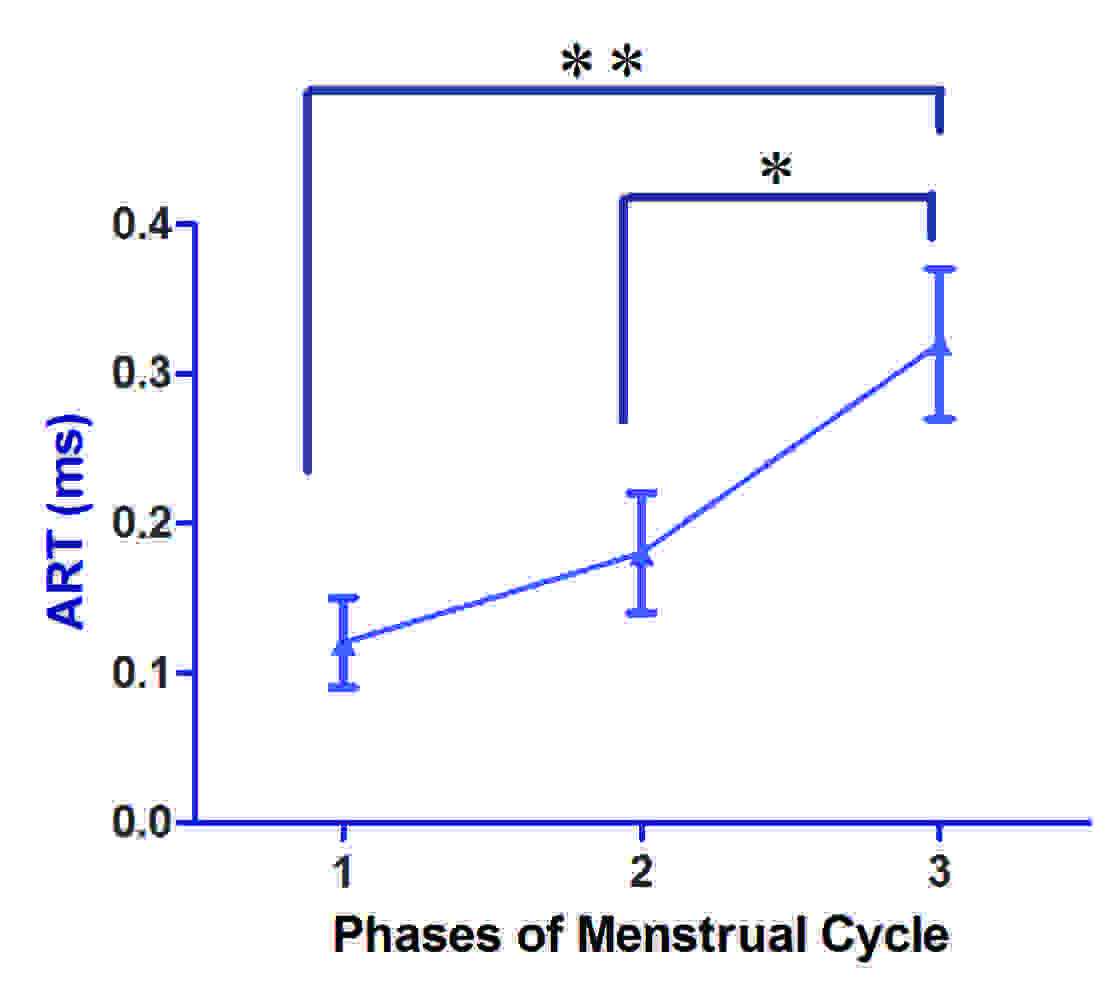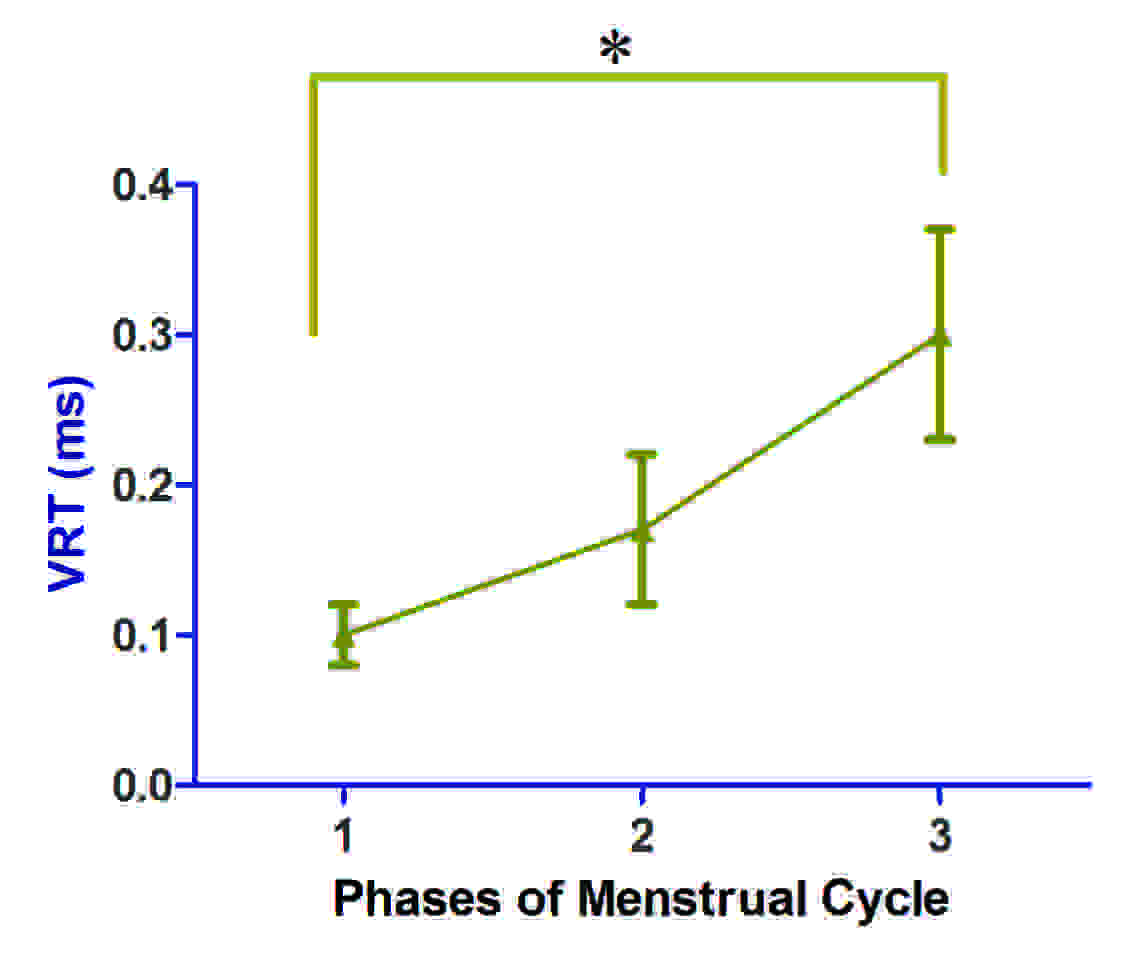Variation of Reaction Time in Different Phases of Menstrual Cycle
Sunil Kumar1, Mehak Mufti2, Ravikiran Kisan3
1 Professor, Department of Physiology, SSIMS& RC, Davangere, Karnataka, India.
2 Post Graduate Student, Department of Physiology, SSIMS& RC, Davangere, Karnataka, India.
3 Assistant Professor, Department of Physiology, SSIMS& RC, Davangere, Karnataka, India.
NAME, ADDRESS, E-MAIL ID OF THE CORRESPONDING AUTHOR: Dr. Ravikiran Kisan, Assistant Professor, Department of Physiology, SSIMS & RC, Davangere, Karnataka,India.
Phone: 09945447207,
E-mail: drravikirankisan@gmail.com
Objective: To evaluate the influence of menstrual cycle on auditory and visual reaction times.
Method: This study was conducted on thirty, healthy, regularly menstruating female subjects who were in the age group of 18-25 years. Influence of different phases of menstrual cycle on Auditory Reaction Time (ART) and Visual Reaction Time (VRT) was evaluated by using a portable audiovisual reaction time apparatus.
Result: The statistical tests which were used were ANOVA and Students ‘t’ test, which showed that there were significant increases in ART and VRT during luteal phase, as compared to those in follicular phase.
Conclusion: Changes in ART and VRT during different phases of menstrual cycle could be due to changes in the levels of female sex hormones, which in turn may lead to salt and water retention.
Auditory reaction time,Visual reaction time,Menstrual cycle
Introduction
Menstrual cycle refers to the cyclic changes which occur in the endometrium during active reproductive years in females, leading to a recurrent monthly bleeding per vaginum. Menstrual cycle of 28 days can be divided into 3 phases, menstrual, proliferative (follicular), and luteal (secretory). About 24 hours before the end of menstrual cycle, oestrogen and progesterone levels decline, resulting in menstrual bleeding. This is followed by a proliferative phase which is under the influence of oestrogen and then the secretory phase, which is under the influence of oestrogen and progesterone [1].
Gonadal hormones not only influence the reproductive functions, but they also display neuroactive effects [2]. Some behavioural and neurological symptoms like a decreased concentration, nervous irritability, emotional instability, poor judgement, depression and tension are seen in women during the premenstrual phase [3].
Reaction time is used to measure the ability in processing information and in judging the ability to concentrate and coordinate [4]. Reaction time is defined as the time interval between the application of a stimulus and an appropriate voluntary response from the subject [5]. It has been used as a measure of cognition [6].It is considered to be an index of speed of processing [7]. It represents the level of neuromuscular coordination in which the body, through different physical, chemical and mechanical processes, decodes ART and VRT, which travel via afferent pathways and reach the brain as sensory stimuli [8]. Studies have shown that reaction time is significantly prolonged during premenstrual phase [3,5,9,10].
Material and Methods
This study was conducted in the Department of Physiology SSIMS and RC after getting the approval of the institutional ethical committee, from September 2012 to December 2012. Thirty, apparently healthy, eumenorrhic females who were in the age group of 18-25 years, who did not have any history of irregular menstrual cycles, pregnancy, lactation or use of contraceptives in past one year, were included in the study. Subjects with a history of visual or hearing disorders, any psychiatric illness or sleep disorders, smoking or alcohol intake were excluded from the study. The study protocol was explained and informed written consents were obtained from all the volunteers. Detailed personal, medical and menstrual histories were taken from them. Values were recorded on the second day of each phase, between 10 am and 12 noon.
For measuring reaction time, the portable apparatus which was supplied by INCO, Instruments and Chemicals PVT. Ltd, model town Ambala, was used. The subjects were made familiar with the apparatus. Auditory (f=4000Hz) and visual (green light) stimuli were presented to subjects. They were asked to respond as soon as they perceived the stimuli, by pressing response pad to stop the stimuli. The duration between the onset of stimulus and pressing response pad, was taken as the reaction time. Three readings of ART and VRT were taken from the auto display and the lowest value was taken as the measure. All readings were taken at a fixed time of the day, in a quiet room.
Statistical Analysis
Data was analyzed by using ANOVA (one tailed test) and Students ‘t’ test.
Results
[Table/Fig-1] shows the demographic data of the volunteers. The ART and VRT at different phases of menstrual cycle, are shown in [Table/Fig-2 and 3] respectively.
| Mean (n=30) | SD |
|---|
| Age (years) (Range 19-25 years) | 21.33 | 2.34 |
| Height (cm) | 160.70 | 4.55 |
| Weight (kg) | 60.00 | 5.97 |
| BMI (kg/m2) | 23.19 | 1.18 |
| Age at menarche (year) | 13.80 | 0.75 |
| Average duration of menstrual cycle (days) | 28 | 1.41 |
| Average duration of menstrual phase (days) | 5 | 1.54 |
Comparison of Auditory Reaction Time in different phases of menstrual cycle
n=30; ART- Auditory Reaction Time; * p < 0.05, ** p < 0.01.

Comparison of Visual Reaction Time in different phases of menstrual cycle
n=30; VRT-Visual Reaction Time; * p < 0.05

Discussion
In the twenty first century, both males and females are equally involved in the delivery of essential services like medical, police, military and transport, which requires alertness and competitiveness. A faster reaction time is indicative of a better performance [8].
Reaction Time (RT) is a physical skill that depends on a variety of stimuli like age, gender, intensity and duration of the stimuli, practice, fatigue, fasting, exercise and personality type and intelligence of the subject [9].
Pawar et al., attributed the prolongation of ART and VRT in females during premenstrual phase to the female sex hormones, that cause salt and water retention, which in turn influence the process of axonal conduction and availability of neurotransmitters at the synapse [3].
The studies of Lalitha et al., have also shown a positive correlation between reaction time and Body Mass Index (BMI) in females. Higher the BMI, longer the RT. This has been explained on the basis of the salt and water retention which is caused by the female sex hormones, which affect the sensorimotor coordination [4].
Asmitha S et al., concluded that fluctuating levels of oestrogen and progesterone during normal menstrual cycle affect the reaction time [5].
Conclusion
Our study showed prolonged ART and VRT in the luteal phase as compared to those in the follicular phase, which could be attributed to the fluctuating levels of female sex hormones.
Limitations
This study can be authenticated furthermore by correlating our results with those of hormonal assays, which however remains the limitation of this study.
[1]. The gonads: Development and function of reproductive system. In: Barrett KE, Barman SM, Boitano S, Brooks HL. editors Ganong’s Review of Medical Physiology 2012 23 edMc Graw Hill:391-428. [Google Scholar]
[2]. Walpurger V, Pietrowsky R, Kirschbaum C, Wolf OT, Effect of the menstrual cycle on auditory event related potentials Hormones and Behavior 2004 46:600-06. [Google Scholar]
[3]. Pawar BL, Kulkarni MA, Syeda A, Somwanshi ND, Chaudhari SP, Effect of premenstrual stress on cardiovascular system and central nervous system J Obstet Gynecol India 2006 56(2):156-58. [Google Scholar]
[4]. Nikam LH, Gadkari JV, Effect of age, gender and body mass index on visual and auditory reaction times in Indian population Indian J Physiol Pharmacol 2012 56(1):94-99. [Google Scholar]
[5]. Nene AS, Pazare PA, A study of auditory reaction time in different phases of the normal menstrual cycle Indian J Physiol Pharmacol 2010 54(4):386-90. [Google Scholar]
[6]. Der G, Deary IJ, Age and sex differences in reaction time in adulthood: From the United Kingdom health and lifestyle survey Psychology and Aging 2006 21(1):62-73. [Google Scholar]
[7]. Niruba R, Maruthy KN, Assesment of auditory and visual reaction time in type 2 diabetics-A case control study Al Ameen J Med Sci 2011 4(3):274-79. [Google Scholar]
[8]. Shelton J, Kumar GP, Comparision between auditory and visual simple reaction times Neuroscience and Medicine 2010 (1):30-32. [Google Scholar]
[9]. Karia RM, Ghuntla TP, Mehta HB, Gokhale PA, Shah CJ, Effect of gender difference on visual time: A study on medical students of Bhavnagar region IOSR J Pharmacy 2012 2(3):452-54. [Google Scholar]
[10]. Namita Ranjan DP, Shenvi DN, Acomparive study of auditory and visual reaction time in males and females staff during shift duty in the hospital Biomedical Research 2010 21(2):199-203. [Google Scholar]